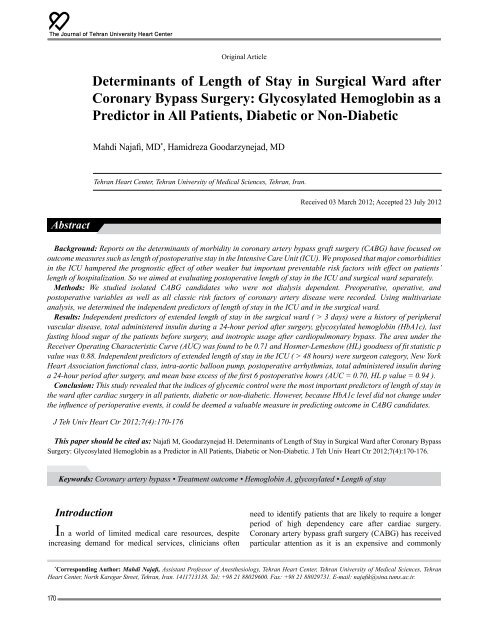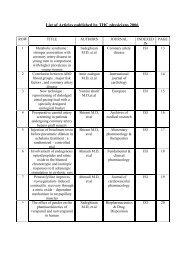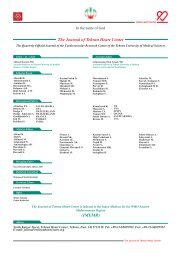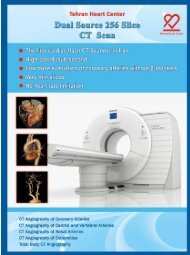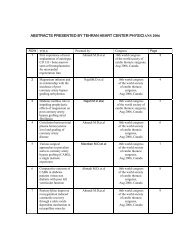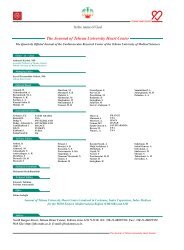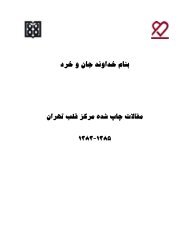THE JOURNAL OF TEHRAN UNIVERSITY HEART CENTER
THE JOURNAL OF TEHRAN UNIVERSITY HEART CENTER
THE JOURNAL OF TEHRAN UNIVERSITY HEART CENTER
You also want an ePaper? Increase the reach of your titles
YUMPU automatically turns print PDFs into web optimized ePapers that Google loves.
The Journal of Tehran University Heart Center<br />
Original Article<br />
Determinants of Length of Stay in Surgical Ward after<br />
Coronary Bypass Surgery: Glycosylated Hemoglobin as a<br />
Predictor in All Patients, Diabetic or Non-Diabetic<br />
Mahdi Najafi, MD * , Hamidreza Goodarzynejad, MD<br />
Tehran Heart Center, Tehran University of Medical Sciences, Tehran, Iran.<br />
Received 03 March 2012; Accepted 23 July 2012<br />
Abstract<br />
Background: Reports on the determinants of morbidity in coronary artery bypass graft surgery (CABG) have focused on<br />
outcome measures such as length of postoperative stay in the Intensive Care Unit (ICU). We proposed that major comorbidities<br />
in the ICU hampered the prognostic effect of other weaker but important preventable risk factors with effect on patients’<br />
length of hospitalization. So we aimed at evaluating postoperative length of stay in the ICU and surgical ward separately.<br />
Methods: We studied isolated CABG candidates who were not dialysis dependent. Preoperative, operative, and<br />
postoperative variables as well as all classic risk factors of coronary artery disease were recorded. Using multivariate<br />
analysis, we determined the independent predictors of length of stay in the ICU and in the surgical ward.<br />
Results: Independent predictors of extended length of stay in the surgical ward ( > 3 days) were a history of peripheral<br />
vascular disease, total administered insulin during a 24-hour period after surgery, glycosylated hemoglobin (HbA1c), last<br />
fasting blood sugar of the patients before surgery, and inotropic usage after cardiopulmonary bypass. The area under the<br />
Receiver Operating Characteristic Curve (AUC) was found to be 0.71 and Hosmer-Lemeshow (HL) goodness of fit statistic p<br />
value was 0.88. Independent predictors of extended length of stay in the ICU ( > 48 hours) were surgeon category, New York<br />
Heart Association functional class, intra-aortic balloon pump, postoperative arrhythmias, total administered insulin during<br />
a 24-hour period after surgery, and mean base excess of the first 6 postoperative hours (AUC = 0.70, HL p value = 0.94 ).<br />
Conclusion: This study revealed that the indices of glycemic control were the most important predictors of length of stay in<br />
the ward after cardiac surgery in all patients, diabetic or non-diabetic. However, because HbA1c level did not change under<br />
the influence of perioperative events, it could be deemed a valuable measure in predicting outcome in CABG candidates.<br />
J Teh Univ Heart Ctr 2012;7(4):170-176<br />
This paper should be cited as: Najafi M, Goodarzynejad H. Determinants of Length of Stay in Surgical Ward after Coronary Bypass<br />
Surgery: Glycosylated Hemoglobin as a Predictor in All Patients, Diabetic or Non-Diabetic. J Teh Univ Heart Ctr 2012;7(4):170-176.<br />
Keywords: Coronary artery bypass • Treatment outcome • Hemoglobin A, glycosylated • Length of stay<br />
Introduction<br />
In a world of limited medical care resources, despite<br />
increasing demand for medical services, clinicians often<br />
need to identify patients that are likely to require a longer<br />
period of high dependency care after cardiac surgery.<br />
Coronary artery bypass graft surgery (CABG) has received<br />
particular attention as it is an expensive and commonly<br />
*<br />
Corresponding Author: Mahdi Najafi, Assistant Professor of Anesthesiology, Tehran Heart Center, Tehran University of Medical Sciences, Tehran<br />
Heart Center, North Karegar Street, Tehran, Iran. 1411713138. Tel: +98 21 88029600. Fax: +98 21 88029731. E-mail: najafik@sina.tums.ac.ir.<br />
170


